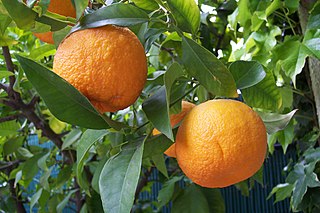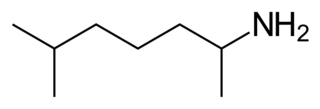Vitamin E is a group of eight fat soluble compounds that include four tocopherols and four tocotrienols. Vitamin E deficiency, which is rare and usually due to an underlying problem with digesting dietary fat rather than from a diet low in vitamin E, can cause nerve problems. Vitamin E is a fat-soluble antioxidant which may help protect cell membranes from reactive oxygen species. Worldwide, government organizations recommend adults consume in the range of 3 to 15 mg per day. As of 2016, consumption was below recommendations according to a worldwide summary of more than one hundred studies that reported a median dietary intake of 6.2 mg per day for alpha-tocopherol.

A dietary supplement is a manufactured product intended to supplement a person's diet by taking a pill, capsule, tablet, powder, or liquid. A supplement can provide nutrients either extracted from food sources, or that are synthetic. The classes of nutrient compounds in supplements include vitamins, minerals, fiber, fatty acids, and amino acids. Dietary supplements can also contain substances that have not been confirmed as being essential to life, and so are not nutrients per se, but are marketed as having a beneficial biological effect, such as plant pigments or polyphenols. Animals can also be a source of supplement ingredients, such as collagen from chickens or fish for example. These are also sold individually and in combination, and may be combined with nutrient ingredients. The European Commission has also established harmonized rules to help insure that food supplements are safe and appropriately labeled.

Bitter orange, sour orange, Seville orange, bigarade orange, or marmalade orange is the citrus tree Citrus × aurantium and its fruit. It is native to Southeast Asia and has been spread by humans to many parts of the world. It is probably a cross between the pomelo, Citrus maxima, and the mandarin orange, Citrus reticulata.

A multivitamin is a preparation intended to serve as a dietary supplement with vitamins, dietary minerals, and other nutritional elements. Such preparations are available in the form of tablets, capsules, pastilles, powders, liquids, or injectable formulations. Other than injectable formulations, which are only available and administered under medical supervision, multivitamins are recognized by the Codex Alimentarius Commission as a category of food.

Nootropics are numerous natural, semi-synthetic and synthetic molecules which purportedly improve cognitive functions.

Synephrine, or, more specifically, p-synephrine, is an alkaloid, occurring naturally in some plants and animals, and also in approved drugs products as its m-substituted analog known as neo-synephrine. p-Synephrine and m-synephrine are known for their longer acting adrenergic effects compared to epinephrine and norepinephrine. This substance is present at very low concentrations in common foodstuffs such as orange juice and other orange products, both of the "sweet" and "bitter" variety. The preparations used in traditional Chinese medicine (TCM), also known as Zhi Shi (枳实), are the immature and dried whole oranges from Citrus aurantium. Extracts of the same material or purified synephrine are also marketed in the US, sometimes in combination with caffeine, as a weight-loss-promoting dietary supplement for oral consumption. While the traditional preparations have been in use for millennia as a component of TCM-formulas, synephrine itself is not an approved over the counter drug. As a pharmaceutical, m-synephrine (phenylephrine) is still used as a sympathomimetic, mostly by injection for the treatment of emergencies such as shock, and rarely orally for the treatment of bronchial problems associated with asthma and hay-fever.
Bodybuilding supplements are dietary supplements commonly used by those involved in bodybuilding, weightlifting, mixed martial arts, and athletics for the purpose of facilitating an increase in lean body mass. Bodybuilding supplements may contain ingredients that are advertised to increase a person's muscle, body weight, athletic performance, and decrease a person's percent body fat for desired muscle definition. Among the most widely used are high protein drinks, pre-workout blends, branched-chain amino acids (BCAA), glutamine, arginine, essential fatty acids, creatine, HMB, whey protein, ZMA, and weight loss products. Supplements are sold either as single ingredient preparations or in the form of "stacks" – proprietary blends of various supplements marketed as offering synergistic advantages.
Performance-enhancing substances, also known as performance-enhancing drugs (PEDs), are substances that are used to improve any form of activity performance in humans. A well-known example of cheating in sports involves doping in sport, where banned physical performance-enhancing drugs are used by athletes and bodybuilders. Athletic performance-enhancing substances are sometimes referred as ergogenic aids. Cognitive performance-enhancing drugs, commonly called nootropics, are sometimes used by students to improve academic performance. Performance-enhancing substances are also used by military personnel to enhance combat performance.

Beta-glucans, β-glucans comprise a group of β-D-glucose polysaccharides (glucans) naturally occurring in the cell walls of cereals, bacteria, and fungi, with significantly differing physicochemical properties dependent on source. Typically, β-glucans form a linear backbone with 1–3 β-glycosidic bonds but vary with respect to molecular mass, solubility, viscosity, branching structure, and gelation properties, causing diverse physiological effects in animals.

β-Methylphenethylamine is an organic compound of the phenethylamine class, and a positional isomer of the drug amphetamine, with which it shares some properties. In particular, both amphetamine and β-methylphenethylamine are human TAAR1 agonists. In appearance, it is a colorless or yellowish liquid.

Acetildenafil (hongdenafil) is a synthetic drug which acts as a phosphodiesterase inhibitor. It is an analog of sildenafil (Viagra) which has been detected in numerous different brands of "herbal aphrodisiac" products sold in convenience stores that claim to boost libido and alleviate erectile dysfunction.

Methylhexanamine is an indirect sympathomimetic drug invented and developed by Eli Lilly and Company and marketed as an inhaled nasal decongestant from 1948 until it was voluntarily withdrawn from the market in the 1980s.

Phenpromethamine, also known as N,β-dimethylphenethylamine, is a sympathomimetic nasal decongestant of the phenethylamine group. It was previously marketed as a nasal inhaler from 1943 through 1960 but is no longer available. The medication is a stimulant and is banned by the World Anti-Doping Agency. It has been detected in dietary supplements starting in the 2010s.

Octodrine is a stimulant drug whose pharmacology was studied in a dozen animal studies from the 1940s through the 1970s. These studies found that octodrine can increase blood pressure and cardiac output in animals. The drug was previously approved for use by the FDA as an inhalant and in Germany as an oral agent as part of a multicomponent medication, but is no longer available.
Oxilofrine is a substituted phenethylamine stimulant drug chemically related to ephedrine and to synephrine.

Sulfoaildenafil (thioaildenafil) is a synthetic drug that is a structural analog of sildenafil (Viagra). It was first reported in 2005, and it is not approved by any health regulation agency. Like sildenafil, sulfoaildenafil is a phosphodiesterase type 5 inhibitor.

N,α-Diethylphenethylamine is a close chemical analog of methamphetamine, which has been sold as a designer drug. It was originally patented by Knoll Pharma as one of several analogs for pharmaceutical applications. In animal models these analogs showed properties of cognitive enhancement and increased pain tolerance. Nevertheless, this class of compounds was never developed into a medicine. N,α-DEPEA has not been studied in humans, but experts such as Pieter Cohen of Harvard Medical School expect it to be less potent than methamphetamine, but greater than ephedrine.

1,3-Dimethylbutylamine, is a stimulant drug structurally related to methylhexanamine where a butyl group replaces the pentyl group. The compound is an aliphatic amine.
Pre-workout is a generic term for a range of bodybuilding supplement products used by athletes and weightlifters to enhance athletic performance. Supplements are taken to increase endurance, energy, and focus during a workout. Pre-workout supplements contain a variety of ingredients such as caffeine and creatine, differing by capsule or powder products. The first pre-workout product entered the market in 1982, and since then the category has grown in use. Some pre-workout products contain ingredients linked to adverse effects. Although these products are not regulated, the Food and Drug Administration (FDA) warns consumers to be cautious when consuming them.

Desmethylsibutramine is an active metabolite of the anorectic drug sibutramine. It is a more potent monoamine reuptake inhibitor than sibutramine and has been sold as an ingredient in weight loss products sold as dietary supplements, along with related compounds such as the N-ethyl and 3,4-dichloro derivatives.















